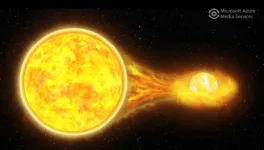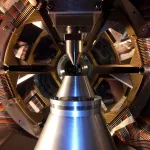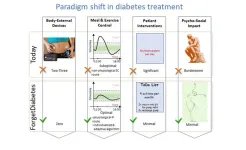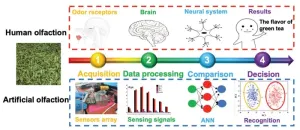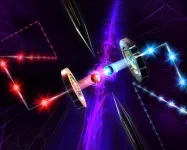(Press-News.org) Led by Kelly Chipps of the Department of Energy’s Oak Ridge National Laboratory, scientists working in the lab have produced a signature nuclear reaction that occurs on the surface of a neutron star gobbling mass from a companion star. Their achievement improves understanding of stellar processes generating diverse nuclear isotopes.
“Neutron stars are really fascinating from the points of view of both nuclear physics and astrophysics,” said ORNL nuclear astrophysicist Kelly Chipps, who led a study published in Physical Review Letters. “A deeper understanding of their dynamics may help reveal the cosmic recipes of elements in everything from people to planets.”
Chipps heads the Jet Experiments in Nuclear Structure and Astrophysics, or JENSA, which has collaborators from nine institutions in three countries. The team uses a unique gas jet target system, which produces the world’s highest-density helium jet for accelerator experiments, to understand nuclear reactions that proceed with the same physics on Earth as in outer space.
The process of nucleosynthesis creates new atomic nuclei. One element can turn into another when protons or neutrons are captured, exchanged or expelled.
A neutron star has an immense gravitational pull that can capture hydrogen and helium from a nearby star. The material amasses on the neutron star surface until it ignites in repeated explosions that create new chemical elements.
Many nuclear reactions powering the explosions remain unstudied. Now, JENSA collaborators have produced one of these signature nuclear reactions in a lab at Michigan State University. It directly constrains the theoretical model typically used to predict element formation and improves understanding of the stellar dynamics that generate isotopes.
Built at ORNL and now at the Facility for Rare Isotope Beams, a DOE Office of Science user facility that MSU operates, the JENSA system provides a target of lightweight gas that is dense, pure and localized within a couple millimeters. JENSA will also provide the primary target for the Separator for Capture Reactions, or SECAR, a detector system at FRIB that allows experimental nuclear astrophysicists to directly measure the reactions that power exploding stars. Co-author Michael Smith of ORNL and Chipps are members of SECAR’s project team.
For the current experiment, the scientists struck a target of alpha particles (helium-4 nuclei) with a beam of argon-34. (The number after an isotope indicates its total number of protons and neutrons.) The result of that fusion produced calcium-38 nuclei, which have 20 protons and 18 neutrons. Because those nuclei were excited, they ejected protons and ended up as potassium-37 nuclei.
High-resolution charged-particle detectors surrounding the gas jet precisely measured energies and angles of the proton reaction products. The measurement took advantage of detectors and electronics developed at ORNL under the leadership of nuclear physicist Steven Pain. Accounting for the conservation of energy and momentum, the physicists back-calculated to discover the dynamics of the reaction.
“Not only do we know how many reactions occurred, but also we know the specific energy that the final potassium-37nucleus ended up in, which is one of the components predicted by the theoretical model,” Chipps said.
The lab experiment improves understanding of nuclear reactions that occur when material falls onto the surface of an important subset of neutron stars. These stars are born when a massive star runs out of fuel and collapses into a sphere about as wide as a city such as Atlanta, Georgia. Then gravity squeezes fundamental particles as close together as they can get, creating the densest matter we can directly observe. One teaspoon of neutron star would weigh as much as a mountain. Neutron-packed stars rotate faster than blender blades and make the universe’s strongest magnets. They have solid crusts surrounding liquid cores containing material shaped like spaghetti or lasagna noodles, earning them the nickname “nuclear pasta.”
“Because neutron stars are so weird, they are a useful naturally occurring laboratory to test how neutron matter behaves under extreme conditions,” Chipps said.
Achieving that understanding takes teamwork. Astronomers observe the star and collect data. Theoreticians try to understand physics inside the star. Nuclear physicists measure nuclear reactions in the lab and test them against models and simulations. That analysis reduces large uncertainties resulting from a dearth of experimental data. “When you put all of those things together, you really start to understand what’s happening,” Chipps said.
“Because the neutron star is superdense, its huge gravity can pull hydrogen and helium over from a companion star. As this material falls to the surface, the density and temperature grow so high that a thermonuclear explosion can occur that can propagate across the surface,” Chipps said. Thermonuclear runaway transforms nuclei into heavier elements. “The reaction sequence can produce dozens of elements.”
Surface explosions do not destroy the neutron star, which goes right back to what it was doing before: feeding off its companion and exploding. Repeated explosions pull crust material into the mix, creating a bizarre composition in which heavy elements formed during previous explosions react with lightweight hydrogen and helium.
Theoretical models predict which elements form. Scientists typically analyze the reaction that the JENSA team measured using a statistical theoretical model called the Hauser-Feshbach formalism, which assumes that a continuum of excited energy levels of a nucleus can participate in a reaction. Other models instead assume that only a single energy level participates.
“We’re testing the transition between the statistical model being valid or invalid,” Chipps said. “We want to understand where that transition happens. Because Hauser-Feshbach is a statistical formalism — it relies on having a large number of energy levels so effects over each individual level are averaged out — we’re looking for where that assumption starts to break down. For nuclei like magnesium-22 and argon-34, there’s an expectation that the nucleus doesn’t have enough levels for this averaging approach to be valid. We wanted to test that.”
A question remained about whether the statistical model was valid for such reactions taking place in stars rather than earthly laboratories. “Our result has shown that the statistical model is valid for this particular reaction, and that removes a tremendous uncertainty from our understanding of neutron stars,” Chipps said. “It means that we now have a better grasp of how those nuclear reactions are proceeding.”
Next, the researchers will try to improve the statistical model by further testing its limits. A past paper explored atomic mass 22, a magnesium nucleus, and found the model incorrect by almost a factor of 10. The current ORNL-led paper, probing 12 atomic mass units above this, found that the model correctly predicted reaction rates.
“Somewhere between [atomic] mass 20 and 30, this transition between where the statistical model is valid and where it’s not valid is taking place,” Chipps said. “The next thing is to look for reactions in the middle of that range to see where this transition is occurring.” Chipps and her JENSA collaborators have begun that endeavor.
The title of the paper is “First direct measurement of the 34Ar(α,p)37K reaction cross section for mixed hydrogen and helium burning in accreting neutron stars.”
DOE’s Office of Science, the National Science Foundation and ORNL’s Laboratory Directed Research and Development program supported the work.
UT-Battelle manages ORNL for the Department of Energy’s Office of Science, the single largest supporter of basic research in the physical sciences in the United States. The Office of Science is working to address some of the most pressing challenges of our time. For more information, please visit energy.gov/science. — Dawn Levy
END
Element creation in the lab deepens understanding of surface explosions on neutron stars
2023-05-23
ELSE PRESS RELEASES FROM THIS DATE:
New treatment helps people stop addictive opioid painkillers used for chronic pain
2023-05-23
Programme of combined one-to-one and group support sessions was tested in landmark clinical trial
After one year, one in five people were able to stop taking opioids without their pain increasing
Experts say the new treatment is an alternative to opioid use and has potential to give patients better quality of life
Researchers at the University of Warwick and The James Cook University Hospital, Middlesbrough have led a clinical trial, funded by the National Institute for Health and Care Research (NIHR), on a new treatment which can help people stop needing to use opioid painkillers to manage chronic pain.
There are over 1 ...
CT scan best at predicting heart disease risk in middle age
2023-05-23
CHICAGO ---CT scans are better at predicting a middle-aged person’s risk for a heart disease, such as a heart attack, than genetics, reports a new Northwestern Medicine study.
“Finding the best way to identify who is at risk for developing heart disease can help determine what needs to be done to lower their risk,” said lead study author Dr. Sadiya Khan, an assistant professor of medicine and preventive medicine at Northwestern University Feinberg School of Medicine and a Northwestern Medicine cardiologist. “This finding can help doctors and patients in managing risk for heart disease, which is the leading cause ...
Study: Transcatheter mitral valve repair safe, successful
2023-05-23
Long-awaited outcomes data of transcatheter edge-to-edge procedures to repair patients’ leaky mitral valves revealed the minimally invasive procedure to be safe and effective in nearly 90% of patients, according to Cedars-Sinai physician-scientists.
Their findings on the condition called degenerative mitral regurgitation were published today in the peer-reviewed Journal of the American Medical Association (JAMA), representing the largest study to date that examines outcomes for patients treated outside of a clinical trial with transcatheter edge-to-edge repair (TEER).
“Treatment was successful in nearly nine out of every 10 patients in whom TEER was used to repair ...
Artificial pancreas reduces disease management burden for people with diabetes
2023-05-23
WASHINGTON, May 23, 2023 – Type 1 diabetes affects 46.3 million people worldwide, and the number of people affected increases by about 3% each year. It requires careful calculations of insulin needs and bothersome daily injections to avoid peripheral diseases caused by extremes of high or low blood sugar.
Automated insulin delivery systems, also called artificial pancreases, make diabetes management much less onerous for patients. These systems — with implanted insulin sensors, pumps that ...
Electronic noses sniff out volatile organic compounds
2023-05-23
WASHINGTON, May 23, 2023 – Volatile organic compounds are chemicals emitted as gases that can have adverse health effects. They are often found in paints, pharmaceuticals, and refrigerants, among other common products, but they can also act as markers of explosives, insect infestation, food spoilage, and disease.
Tracing VOCs is important for public safety and all “smell” related issues. To this end, in Applied Physics Reviews, from AIP Publishing, Liu et al. introduced a fluid mechanics-based chamber design for an electronic nose (e-nose) that consistently detects ...
Neighborhood income mobility and risk of neonatal and maternal morbidity
2023-05-23
bout The Study: In this study of women living in low-income areas, those who moved to a higher-income area between births experienced less morbidity and death in their second pregnancy, as did their newborns, compared with those who remained in low-income areas between births. Research is needed to determine whether financial incentives or enhancement of neighborhood factors can reduce adverse maternal and perinatal outcomes.
Authors: Joel G. Ray, M.D., M.Sc., of the University of Toronto, is the corresponding author.
To ...
Factors associated with protection from SARS-CoV-2 Omicron variant infection and disease among vaccinated health care workers
2023-05-23
About The Study: Immunoglobin G and neutralizing antibody titer levels were associated with protection against infection with the Omicron variant and against symptomatic disease in this study that included 2,300 vaccinated health care workers in Israel.
Authors: Gili Regev-Yochay, M.D., of the Sheba Medical Center in Ramat Gan, Israel, is the corresponding author.
To access the embargoed study: Visit our For The Media website at this link https://media.jamanetwork.com/
(doi:10.1001/jamanetworkopen.2023.14757)
Editor’s ...
Prediabetes and fracture risk among midlife women
2023-05-23
About The Study: The findings in this study of nearly 1,700 midlife women without diabetes suggest that prediabetes was associated with risk of fracture. Future research should determine whether treating prediabetes reduces fracture risk.
Authors: Albert Shieh, M.D., of the David Geffen School of Medicine at University of California, Los Angeles, is the corresponding author.
To access the embargoed study: Visit our For The Media website at this link https://media.jamanetwork.com/
(doi:10.1001/jamanetworkopen.2023.14835)
Editor’s ...
Underreporting of quality measures in nursing home ratings
2023-05-23
About The Study: The results of this quality improvement study involving 13,000 nursing homes suggest widespread underreporting of major injury falls and pressure ulcers, and underreporting was associated with the racial and ethnic composition of a facility. Alternative approaches to measuring quality need to be considered.
Authors: Prachi Sanghavi, Ph.D., of the University of Chicago, is the corresponding author.
To access the embargoed study: Visit our For The Media website at this link https://media.jamanetwork.com/
(doi:10.1001/jamanetworkopen.2023.14822)
Editor’s Note: Please see the article for additional information, including other ...
Boost for the quantum internet
2023-05-23
Quantum networks connect quantum processors or quantum sensors with each other. This allows tap-proof communication and high-performance distributed sensor networks. Between network nodes, quantum information is exchanged by photons that travel through optical waveguides. Over long distances, however, the likelihood of photons being lost increases dramatically. As quantum information cannot simply be copied and amplified, 25 years ago Hans Briegel, Wolfgang Dür, Ignacio Cirac and Peter Zoller, then all at the University of Innsbruck, provided the blueprints for a quantum repeater. These feature light-matter entanglement sources and memories ...
